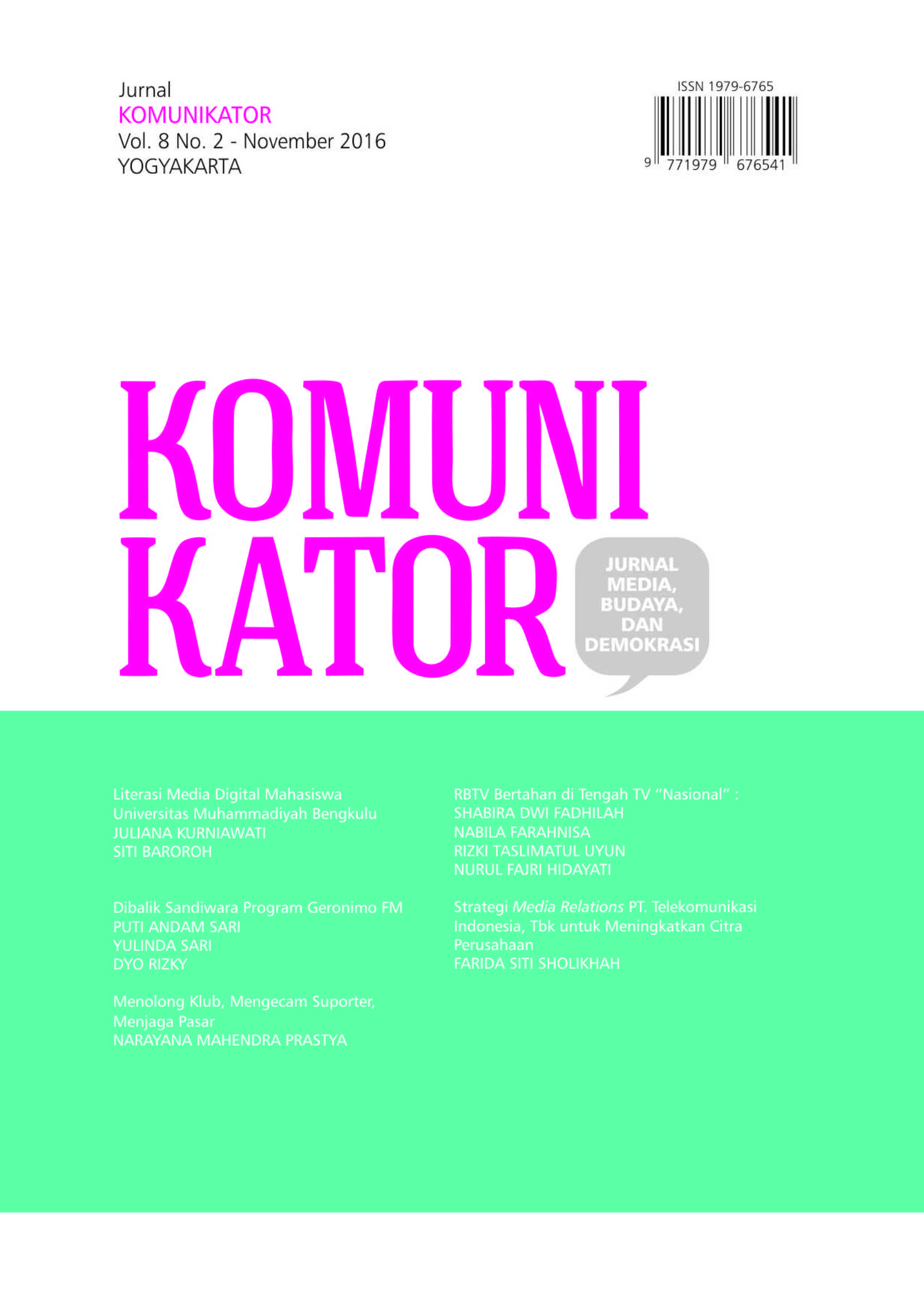Bertahan di Tengah TV “Nasional” : Strategi Manajemen RBTV Melalui TV Jaringan dengan KOMPAS TV
Abstract
This research was held to find out how the local television, which is RBTV, survived from “national” television by its segmentation, targeting, and positioning way. This research is important because the result is expected to be a reference for other local televisions to keep their existence and survive against many other “national” televisions. This research discusses about how RBTV’s strategy as one of local television survived from many other local televisions and “national” televisions. The research method was qualitative descriptive and for the informant was getting by purposive sampling technique. The conclusion of the research is the cooperation between KOMPAS TV and RBTV as a networked television, made mass media (especially television) escaped from media policy and goals changing and also homogenity of news and information as the results from media diversification. Other “national” television station should follow KOMPAS TV ways by networked television with RBTV to create the opportunity for local television, so they can compete with other “national” television all over Indonesia. Other local televisions are hoped to follow RBTV’s strategy through networked television with KOMPAS TV to survive from tight competition among other local television.
References
Bungin, Burhan (2011). Penelitian Kualitatif. Jakarta, Prenada Media Grup.
Idrus, Muhammad (2009). Metode Penelitian Ilmu Sosial Pendekatan Kualitatif dan Kuantitatif. Jakarta, Erlangga.
Junaedi, Fajar (2014). Manajemen Media Massa Teori Aplikasi dan Riset. Yogyakarta, Buku Litera.
Kasiram, H. Moh (2010). Metodologi Penelitian Kualitatif-Kuantitatif. Malang, UIN Maliki Press.
Rangkuti, Freddy (2010). Analisis SWOT Teknik Membedah Kasus Bisnis. Jakarta, PT Gramedia Pustaka Utama.
Sugiyono (2009). Metode Penelitian Kuantitatif dan Kualitatif dan R&D. Bandung, Alfabeta.
Zulfiningrum, Rahmawati (2014). Spasialisasi dan Praktik Konglomerasi Media Kelompok Kompas Gramedia, dalam Jurnal ASPIKOM Vol. 2 No. 2 Juli, 2014.
Downloads
Published
Issue
Section
License
Copyright
The Authors submitting a manuscript do so on the understanding that if accepted for publication, copyright of the article shall be assigned to Komunikator as publisher of the journal. Copyright encompasses rights to reproduce and deliver the article in all form and media, including reprints, photographs, microfilms, and any other similar reproductions, as well as translations.
Authors should sign Copyright Transfer Agreement when they have approved the final proofs sent by Komunikator prior the publication. Komunikator strive to ensure that no errors occur in the articles that have been published, both data errors and statements in the article.
Komunikator keep the rights to articles that have been published. Authors are allowed to use their works for any purposes deemed necessary without written permission from Komunikator with an acknowledgement of initial publication in this journal.
License
All articles published in Komunikator are licensed under a Creative Commons Attribution-ShareAlike 4.0 International (CC BY-SA) license. You are free to:
- Share — copy and redistribute the material in any medium or format
- Adapt — remix, transform, and build upon the material for any purpose, even commercially.
- Attribution — You must give appropriate credit, provide a link to the license, and indicate if changes were made. You may do so in any reasonable manner, but not in any way that suggests the licensor endorses you or your use.
- ShareAlike — If you remix, transform, or build upon the material, you must distribute your contributions under the same license as the original.
- No additional restrictions — You may not apply legal terms or technological measures that legally restrict others from doing anything the license permits.





